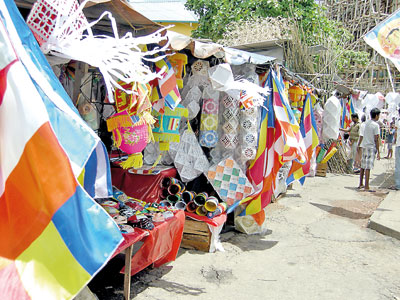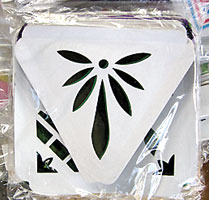Blowing in rhythm with the wind
Whether traditional bamboo and tissue paper or more modern plastic, Vesak lanterns are a sight that gladden the eyes
A line of illuminated Vesak lanterns or kudus, even in the humblest home is a sight that never fails to gladden the eye as Sri Lanka celebrates the thrice hallowed festival, marking the birth, enlightenment and passing away of Lord Buddha.

Different types of Vesak lanterns. Pix by Athula Devapriya
Children in particular delight in making the lanterns and this was a regular pastime in every home in the days leading up to Vesak in years gone by. Now in this ‘instant age’, city dwellers in particular have taken to buying lanterns and stalls selling readymade lanterns had brisk business this week.
Vesak lanterns have changed over the years. The traditional lanterns were made out of strips of bamboo, tissue paper, thread and glue or paappa (traditional glue made out of plain baking flour and water).
The frame or the structure of the basic lantern is made of bamboo sticks tied together to form the shape of an atapattama. Now along with the traditional atapattama we see different and more intricate structures, from the six-sided to 18-sided single lantern –lotus shapes, lanterns shaped like planes, helicopters, the Temple of the Tooth, and so much more.
Just like the traditional Vesak kudus, these too have the long tassels that blow in rhythm with the wind. Cardboard lanterns made by stapling the edges together, framed with glass paper are common now, cheaper than the bamboo-framed lanterns and less likely to tear.
There were also the plastic framed lanterns in packets for Rs. 50 upwards: you could assemble them yourself and have the satisfaction of pasting the tissue paper on.The much admired intricate designs on the lanterns that had to be cut several months before the Vesak season now are done within minutes using stencils and machine cutters. All that needs to be done is to paste them neatly on the lanterns.
The plastic Chinese lanterns come in pretty designs and can be put away for later use just like the cloth lanterns that are now making an appearance. The Chinese lanterns come in an easy-to-store pack that contains instructions in English that makes assembling easy. They are priced between Rs. 300 and Rs. 1000 and many stall owners prefer them to the traditional lanterns for they can be stored and sold the next year as well.

Chinese lanterns come in easy-to-store packs
At a lantern stall in Kirulapone, the plane-shaped and the helicopter-shaped kudus have been snapped up fast, mainly by families with children badgering their parents for these unusual shapes over the conventional kudus.
“We always have the frames ready and quickly scallop the tissue paper over it according to the requested colours then and there,” owner of the stall Mrs. Sivakumar says.
The impressive models of the Temple of the Tooth come in quite large sizes and have rigifoam ‘roofs’. A transparent polythene wrapping which may cost around Rs. 50 can also be had to keep the lantern safe from the elements of nature.
Quiet different from the days of the simple home-made ‘kudu’ indeed but the enthusiasm to spread the light of Vesak has not dimmed.
Follow @timesonlinelk
comments powered by Disqus


